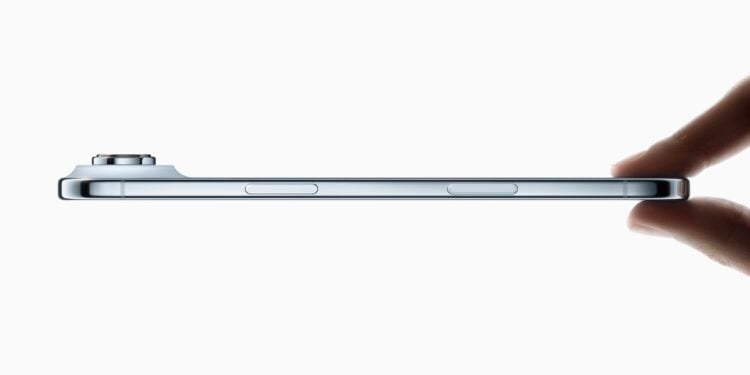With the iPhone Air, Apple has introduced the thinnest iPhone yet. The device combines a new design with familiar features, but a closer look reveals several differences from the Pro and standard models. These aspects were barely touched upon in the keynote, but they are nevertheless crucial for properly classifying the iPhone Air.
The iPhone Air sits between the regular models and the Pro versions. It's lighter, slimmer, and makes a bold design statement. However, this also means certain compromises have been made. Some aspects are invisible at first glance, others only become apparent when comparing technical specifications or details from Apple's own website.
A19 Pro chip with slimmed-down GPU
The iPhone Air features the A19 Pro chip. Unlike the A19 Pro in the iPhone 17 Pro, which offers a 6-core CPU and 6-core GPU, the iPhone Air only comes with a 6-core CPU and 5-core GPU. At first glance, this is reminiscent of the standard A19 in the iPhone 17. However, there are differences: The A19 Pro in the Air is more efficient and has 12 GB of RAM, while the standard A19 in the iPhone 17 has only 8 GB.
USB-C with USB 2 speed
The USB-C port in the iPhone Air only supports USB 2. This means transfer rates are significantly slower than those on the iPhone 17 Pro, which supports USB 3 and up to 10 Gb/s. The port's position is also striking. It's not exactly in the center of the bottom panel, but slightly offset—a hint at how tight the space is within the slim case.
Deeper Dynamic Island
The iPhone Air's Dynamic Island extends further into the screen than other models. Apple has moved many critical components to the top of the device, necessitating this adjustment.
Only one speaker
The iPhone Air has only one speaker in the earpiece. The openings at the bottom are microphones, not speakers. Stereo sound requires accessories like AirPods or an external speaker.
Slower wired charging
The iPhone Air charges more slowly via cable than the other models. With a 20W power adapter, it reaches 50 percent in 30 minutes. The iPhone 17 and iPhone 17 Pro achieve the same level of charge in just 20 minutes with 40W. However, the familiar 50 percent charge in 30 minutes is maintained via MagSafe.
Connectivity without mmWave
The iPhone Air uses Apple's proprietary C1X modem. This means it lacks support for mmWave 5G in the US. However, new standards have been introduced: Apple's proprietary N1 network chip supports Wi-Fi 7 and Bluetooth 6.
Camera with only one lens
There's only one camera on the back, which limits its features. Cinema mode, 3D photos and videos, macro shots, or ProRAW aren't available. ProRes video, LOG recording, and studio-quality microphones are also missing. This makes the iPhone Air less suitable for professional photo and video use, but it's still adequate for everyday photos.
- AirPods Pro 3: Apple's headphones with 8 exciting upgrades
- AirPods Pro 3 vs. AirPods Pro 2: The big comparison in detail
- Is the iPhone 17 Pro not worth it? The iPhone 18 Pro in focus
iPhone Air between design focus and compromises
The iPhone Air is an unusual device in Apple's iPhone lineup. A sleek design and a powerful chip make it attractive, but compromises are inevitable in several areas. These include the camera, charging speed, USB-C port, and sound. Those seeking the thinnest iPhone with a clear design focus will find the iPhone Air an exciting option. For maximum performance and a full range of features, the iPhone 17 Pro remains the better choice. The best products for you: Our Amazon storefront offers a wide selection of accessories, including HomeKit accessories. (Image: Apple)
- AirPods Pro 3: Surprise discovered in battery life
- iPhone 17: Differences between A19 and A19 Pro
- iPhone Air weight: Comparison of all current Apple models
- iPhone 17: Apple brings significantly longer battery life
- iPhone 17: Apple introduces groundbreaking security feature
- iPhone 17: Dual Capture Video now directly in the Camera app
- macOS 26 brings repair assistant for calibration & parts
- iPhone Air with C1X modem – faster, more efficient, better
- iPhone 17 Pro uses aluminum – all the reasons in detail
- iPhone 17: N1 chip, more RAM and battery life at a glance
- High blood pressure warnings coming to older Apple Watch models
- AirPods Pro 2 and AirPods 4 get live translation feature
- MagSafe battery exclusively for iPhone Air – iPhone 17 runs out of power
- New iPhone accessories 2025: cases, bumpers and crossbody
- Final Cut Camera 2.0: All new features at a glance
- iPhone Air battery life: Comparison with iPhone 17 and predecessors
- iPhone 17: There is no longer a SIM slot in these countries
Frequently Asked Questions about iPhone Air
The iPhone Air is Apple's thinnest iPhone yet. It combines an ultra-lightweight design with a powerful A19 Pro chip, but it does have some compromises.
The iPhone Air features the A19 Pro chip. Unlike the iPhone 17 Pro, it only has a 5-core GPU, but 12 GB of RAM for greater efficiency.
The iPhone Air charges with a cable at a maximum of 20 watts. It reaches 50 percent in 30 minutes. MagSafe also allows 50 percent in 30 minutes.
The iPhone Air has a USB-C port, but it only supports USB 2 speeds. This makes data transfers slower than on the Pro.
No, the iPhone Air only has a mono speaker in the earpiece. For stereo sound, AirPods or external speakers are required.
The iPhone Air has only a single camera on the back, so features like Cinema mode, macro shots, or ProRAW aren't available.
The iPhone Air uses Apple's C1X modem. It lacks mmWave 5G, but supports modern standards like Wi-Fi 7 and Bluetooth 6.
The iPhone Air is aimed at users who value design, lightweight design, and everyday usability. For professional photography or maximum performance, the iPhone 17 Pro is better suited.





